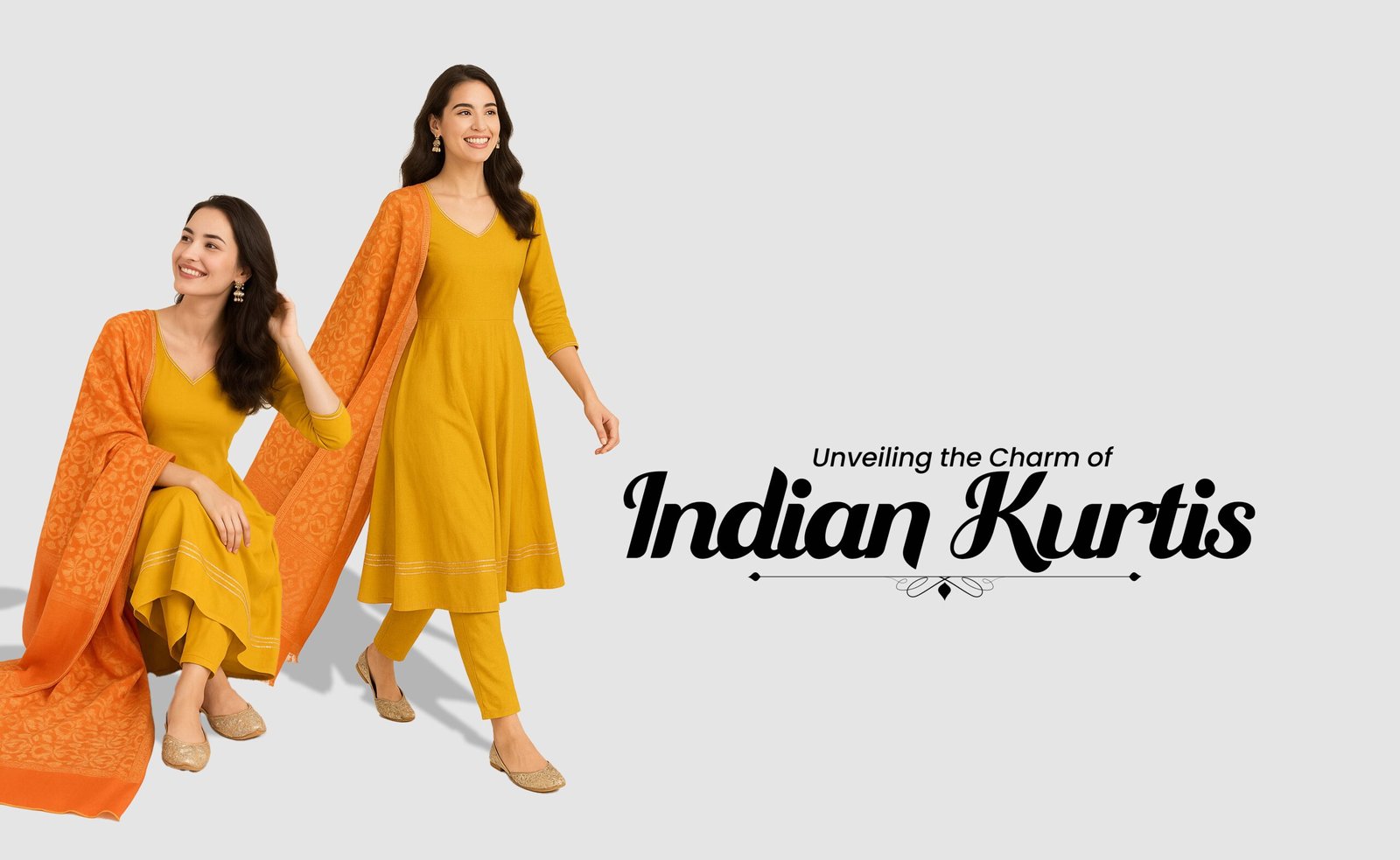Exploring the Vibrant World of Traditional Indian Kurtis for Women

Introduction to Kurtis
Kurtis, an integral component of traditional Indian attire, represent a blend of cultural heritage and contemporary fashion. These garments are characterized by their elegant and stylish silhouette, which makes them suitable for a variety of occasions, from casual outings to formal events. Originating from the Indian subcontinent, kurtis have evolved significantly over time, retaining their prominence in women’s wardrobes across different age groups.
The versatility of kurtis lies in their ability to be paired with various bottom wear options, such as leggings, palazzos, or even jeans, catering to both traditional and modern style preferences. This adaptability has significantly contributed to their status as a staple garment among women. The wide range of designs, fabrics, and embellishments available in kurtis allows for personal expression, ensuring that each woman can find a kurti that reflects her unique style and personality.
In recent years, the popularity of kurtis has surged, particularly in contemporary fashion circles. Designers have started reimagining traditional styles, incorporating modern elements and global fashion trends. This resurgence can be attributed to the growing interest in ethnic wear, as kurtis are embraced for their comfort, style, and inherent connection to Indian culture. With the introduction of various prints, patterns, and cuts, the modern kurti caters to diverse tastes and preferences, making it relevant in today’s fashion landscape.
Moreover, the ease of wear and maintenance associated with kurtis makes them a favored choice among women of all ages. Whether it is for a family gathering, a festive celebration, or a day at the office, kurtis have established themselves as a go-to option that seamlessly transitions across different contexts. As such, the enduring charm of kurtis continues to thrive, reflecting the vibrant spirit of women’s fashion in India.
Anarkali Kurtis: The Regal Charm
The Anarkali kurti is a timeless garment that embodies the regal charm and rich cultural heritage of India. This traditional wear traces its origins back to the Mughal era, where it is said to have been named after a legendary courtesan, Anarkali. Known for its flared silhouette, the Anarkali kurti features a fitted bodice that gradually expands into a broad, flowing skirt. This distinctive design not only flatters various body types but also adds an elegant touch to any feminine ensemble. Over the years, the Anarkali kurti has transcended its royal beginnings, becoming a staple in modern Indian wardrobes.
Anarkali kurtis are particularly popular during weddings and festive occasions. Their extravagant designs and vibrant colors make them an ideal choice for celebratory events. Whether it’s a grand wedding reception or a traditional festival, the Anarkali kurti can be styled in numerous ways to enhance its beauty. Often paired with churidars, palazzos, or leggings, these kurtis strike the perfect balance between tradition and contemporary fashion.
The versatility of Anarkali kurtis allows them to be styled in myriad ways, making them suitable for diverse occasions. Whether it’s a formal gathering or a festive celebration, these kurtis remain a favored choice among women seeking to express their cultural identity while embracing contemporary fashion trends.
Straight-cut Kurtis: The Classic Choice
Straight-cut kurtis have emerged as a quintessential element of women’s fashion, appreciated for their timeless charm and versatility. Characterized by a straight silhouette that falls gracefully from the shoulders, these kurtis offer a flattering fit that complements various body types. Typically, straight-cut kurtis come in varying lengths, ranging from hip-length to knee-length, making them suitable for a plethora of occasions, from casual outings to professional environments.
The structure of straight-cut kurtis is designed to provide ease of movement while exuding elegance. Often crafted from breathable fabrics such as cotton, silk, and linen, they are ideal for warm climates, ensuring comfort throughout the day. The simplicity of their design allows for a multitude of styling options, as they can be effortlessly paired with different types of bottoms. For a relaxed look, straight-cut kurtis can be worn with leggings or churidars, offering a blend of comfort and style. Alternatively, for a more polished appearance, they can be matched with palazzos or tapered trousers, making them a perfect choice for formal gatherings, office wear, and even festive occasions.
Moreover, straight-cut kurtis can be adorned with various embellishments, prints, and patterns, thus adding to their appeal. Whether opting for intricate embroidery or contemporary prints, women can express their individual styles while retaining a classic look. Accessories also play a significant role in elevating the overall aesthetic; simple jewelry pairs well with these kurtis, allowing for versatility across different settings. Ultimately, straight-cut kurtis serve as a classic choice in women’s wardrobes, offering a seamless blend of traditional Indian attire with modern fashion sensibilities.
A-Line Kurtis: Simple Yet Elegant
A-line kurtis represent a fundamental style in traditional Indian attire, characterized by their flattering silhouette that complements a variety of body types. This design is tailored to gently flares out from the waist, creating an “A” shape that enhances natural curves while providing comfort and freedom of movement. Due to their versatile nature, A-line kurtis are a staple in many women’s wardrobes, seamlessly transitioning from casual to formal occasions with ease.
One of the defining features of A-line kurtis is their diverse range of lengths and styles. They can be found in knee-length, calf-length, or even ankle-length designs, each offering a unique aesthetic while maintaining the classic A-line structure. Moreover, A-line kurtis are often embellished with intricate embroidery, mirror work, or ethnic prints, enabling wearers to express their individuality through various styles. This adaptability in design allows A-line kurtis to cater to different tastes and preferences, making them suitable for a multitude of settings.
The versatility of A-line kurtis extends to occasions as well. They can be effortlessly styled for a variety of events, whether it is a festive gathering, a wedding, or a casual outing with friends. Pairing an A-line kurti with leggings, palazzos, or churidars can create a chic ensemble ideal for evening celebrations, while a more casual pairing with denim can lend a relaxed yet stylish vibe for day-to-day wear. Furthermore, accessorizing with statement jewelry or a stylish handbag can elevate the look, making A-line kurtis an essential item for every woman’s attire collection.
Floor-Length Kurtis: The Fashion Statement
Floor-length kurtis have emerged as a prominent fashion statement in the realm of women’s ethnic wear. These elegant garments blend traditional Indian aesthetics with modern design sensibilities, creating a versatile piece that caters to a myriad of occasions. Typically, floor-length kurtis feature a relaxed yet refined silhouette, which gracefully enhances the feminine figure, offering an elongated appearance that many women find flattering.
The designs of floor-length kurtis are diverse, ranging from intricate embroidery and embroidery techniques to contemporary patterns. Metallic threads, sequins, and embellished borders add a touch of glamour, making them suitable for cocktail parties and festive events. This style of kurti encapsulates a fusion of traditional craftsmanship with contemporary styles, allowing women to express their unique fashion sense while honoring cultural heritage.
One of the key attractions of floor-length kurtis is their versatility. They can be paired with various accompaniments such as palazzo pants, churidars, or even skirts depending on the desired look. For a sophisticated appeal, women can accessorize floor-length kurtis with statement jewelry, elegant clutches, and stylish footwear. Choosing the right fabric is also crucial—lightweight materials like georgette and chiffon drape beautifully, while more structured fabrics like silk lend an air of grandeur.
When it comes to styling, opt for tailored cuts that define the waist for a more polished appearance. Additionally, layering with a fitted jacket or an embellished dupatta can further elevate the overall look. Floral prints, asymmetrical hemlines, and deep necklines create an added layer of chic appeal, making floor-length kurtis a popular choice for women seeking to make a statement. Ultimately, the infinite styling possibilities only amplify the allure of floor-length kurtis in contemporary wardrobes.
Kaftan Kurtis: Comfort Meets Style
Kaftan kurtis have emerged as a celebrated garment in Indian fashion, epitomizing effortless elegance and comfort. Traditionally characterized by their loose-fitting design, these kurtis derive their essence from the age-old kaftan, which has a rich origin steeped in Middle Eastern and North African culture. Over centuries, as this garment traveled across regions, it found its way into the vibrant sartorial tapestry of India, evolving to harmonize with Indian aesthetics and preferences.
One of the most appealing aspects of kaftan kurtis is undoubtedly their relaxed fit, which provides unparalleled comfort, making them a favored choice for casual outings or leisurely home wear. The breathable fabrics commonly used, such as cotton, linen, and silk, ensure that these kurtis are ideal for varying climates, allowing for ease of movement without compromising style. Often embellished with intricate hand embroidery or eye-catching prints, kaftan kurtis showcase a delightful combination of tradition and contemporary flair, appealing to a diverse audience.
The beauty of kaftan kurtis lies not only in their form but also in the variety of patterns and colors available. From vibrant florals to geometric designs, these kurtis can be styled to suit any occasion, whether it be a family gathering or a day at the beach. Furthermore, the adaptability of kaftan kurtis makes them suitable for layering, allowing for creative styling that incorporates jackets or shawls during cooler months. The wide range of fabric choices also means one can easily find a kaftan kurti that resonates with individual style preferences.
In conclusion, kaftan kurtis exemplify the blend of comfort and style inherent in traditional Indian wear. Their evolution from a historical garment to a contemporary wardrobe staple illustrates the dynamic nature of fashion and the enduring appeal of comfort-driven clothing.
Palazzo and Tunic Sets: The Trendy Fusion
The combination of palazzo pants and tunic sets has emerged as a popular fashion choice, particularly within the realm of traditional Indian kurtis. This trendy fusion is admired for its ability to seamlessly blend comfort with style, appealing to modern women who seek both elegance and ease in their attire. Palazzo pants, characterized by their wide-legged design, offer a flattering silhouette that complements various body types, while tunics, including kurtis, add a touch of ethnic charm.
The rise in popularity of palazzo and tunic sets can be attributed to their versatility. These outfits can be dressed up or down, making them suitable for a range of occasions, from casual outings to formal gatherings. Women can effortlessly transition from day to night by pairing these versatile ensembles with statement accessories or appropriate footwear. For example, wearing a vibrant kurti paired with neutral palazzos can create a chic day look, while a more embellished kurti with intricate designs can elevate the outfit for evening events.
Styling options for palazzo and tunic sets are virtually limitless. Layering with a long, structured jacket or opting for a contrasting stole can enhance the overall aesthetic. Additionally, experimenting with various fabrics—such as cotton for comfort or silk for a touch of luxury—can further personalize the look. When considering where to wear these sets, they can be ideal for various settings including family gatherings, festive occasions, or even casual outings with friends.
The palazzo and tunic set is a testament to the evolving landscape of traditional Indian wear, showcasing how modern silhouettes can coexist with heritage. This fashionable fusion captures the essence of contemporary style while celebrating traditional craftsmanship, making it a must-have in every woman’s wardrobe.
Embroidered and Printed Kurtis: Celebrating Artistry
The world of traditional Indian kurtis is a vibrant tapestry of craftsmanship, showcasing diverse styles and intricate designs. Among these, embroidered and printed kurtis stand out for their artistry, rich cultural significance, and aesthetic versatility. These garments often serve as a canvas for various embroidery techniques that have been passed down through generations, each telling a unique story of origin and skill.
One of the most notable techniques is Chikankari, originating from Lucknow. This exquisite form of hand embroidery employs a series of white threads sewn into fine muslin fabric, creating delicate patterns and motifs that evoke a sense of elegance. Chikankari embroidery is not only beautiful but also reflects the meticulous craftsmanship of artisans who have perfected this technique over the years. Similarly, Zardozi, with its roots in Persian influence, involves intricate work with gold and silver threads, beads, and sequins, offering a luxurious embellishment to kurtis that captures the eye.
In addition to embroidery, the prints utilized in kurtis play a pivotal role in enhancing their visual appeal. Block printing, a traditional Indian art form, involves hand-carving designs into wooden blocks that are then stamped onto fabric. This method celebrates the uniqueness of each piece, as slight variations in print add charm to the garment. Digital prints, on the other hand, have revolutionized the industry by allowing for vibrant, detailed designs that can easily incorporate contemporary themes while retaining cultural essence. With advancements in printing technology, kurtis now feature a wide array of patterns—from floral to geometric—that cater to modern fashion sensibilities.
Ultimately, the combination of intricate embroidery and vibrant prints in traditional Indian kurtis showcases not only the artistry involved but also the enduring legacy of cultural craftsmanship that continues to inspire designers and wearers alike.
Accessorizing Your Kurti: Tips and Trends
Accessorizing a kurti can significantly enhance its appeal and transform your overall look. With a variety of styles and occasions to consider, finding the right accessories is key to creating a balanced outfit. One of the main elements to focus on is jewelry. For casual outings, opt for simple, understated pieces such as stud earrings or a delicate pendant necklace. In contrast, for festive or formal events, consider statement jewelry such as chandelier earrings or a chunky bracelet, which can add a touch of elegance to your ensemble. Layering necklaces can also create visual interest when combined with a plain kurti.
Bags play a crucial role in complementing kurtis. A chic clutch or a sophisticated tote can enhance your outfit’s vibe. When choosing a bag, consider the kurti’s color and style. If you are wearing a printed kurti, a solid-colored bag can create a harmonious look, while a patterned bag can add a fun twist to your ensemble. For a more traditional approach, try pairing your kurti with a potli bag, which adds a vintage charm and is perfect for special occasions.
Shoes are equally important when accessorizing a kurti. For a casual day out, comfortable sandals or stylish sneakers work well and keep your look laid-back yet fashionable. On the other hand, for formal events, opt for embellised heels or juttis that resonate with traditional aesthetics. The choice of footwear should ideally align with the kurti’s length and style—an ankle-length kurti pairs beautifully with traditional mojris, while knee-length variations can be paired with block heels for added height.
As trends evolve, layering has become popular, with long shrugs or jackets being worn over kurtis for a contemporary touch. By choosing the right accessories, you can elevate your kurti ensemble to suit various occasions, making it a versatile staple in your wardrobe. In conclusion, accessorizing intelligently enhances the beauty of traditional Indian kurtis, allowing women to express their unique style and cultural heritage.


